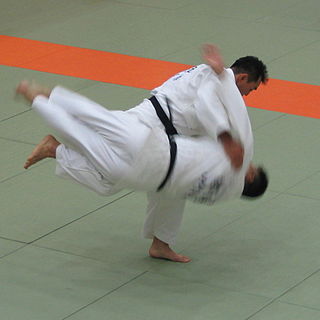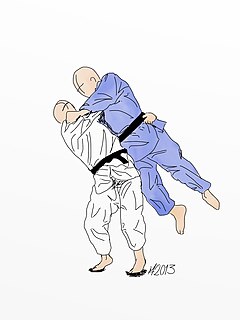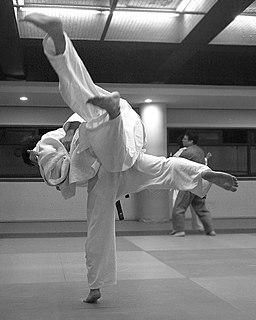
In combat sports, the north–south position is a ground grappling position where one combatant is supine, with the other combatant invertedly lying prone on top, normally with their head over the bottom combatant's chest. The north–south position is a dominant position, where the top combatant can apply effective strikes such as knee strikes to the head, or easily transition into various grappling holds or more dominant positions. Transitioning into side control can be done by first switching into a particular hold known as ushiro-kesa-gatame (後袈裟固) or reverse scarf hold, where the chest points to the side, and the opponent's arm is controlled similarly to kesa-gatame. The north–south choke is employed exclusively from this position.

Kata guruma (肩車) is one of the traditional forty throws of judo as developed by Kano Jigoro. Kata guruma belongs to the third group of the traditional throwing list in the Gokyo no waza of the Kodokan Judo. It is also part of the current 67 Throws of Kodokan Judo. Because the technique is not a sweep nor a trip and requires tori to pull uke into a carry, it is categorized as a hand throwing technique (tewaza).

Deashi Harai (出足払), more accurately romanized: Deashibarai, is one of the original 40 throws of Judo as developed by Jigoro Kano. It belongs to the first group, Dai-Ikkyo, of the traditional throwing list, Gokyo-no-Nagewaza, of Kodokan Judo. It is also part of the current 67 Throws of Kodokan Judo. It is classified as a foot technique, Ashi-Waza. Deashi Harai is also one of the 20 techniques in Danzan Ryu's (DZR) Nagete list.

Ō goshi is one of the original 40 throws of Judo as compiled by Jigoro Kano.

Ōuchi gari (大内刈) is one of the original 40 throws of Judo as developed by Kanō Jigorō. It belongs to the first group, Dai Ikkyo, of the traditional throwing list, Gokyo, of Kodokan Judo. It is also included in the current 67 Throws of Kodokan Judo.It is classified as a foot technique, Ashi-Waza.

Tomoe nage (巴投) is one of the traditional forty throws of jujutsu and Judo. It belongs to the third group (Sankyo) of the traditional throwing list, the traditional Gokyo, and the current 67 Throws of Kodokan Judo.
Yama Arashi is one of the preserved throwing techniques, Habukareta Waza, of Judo. It belonged to the fifth group, Dai Gokyo, of the 1895 Gokyo no Waza lists. It is categorized as a hand throwing technique, Te-waza. It rarely occurs in competition or randori.

Tsurikomi Goshi (釣込腰), is one of the original 40 throws of Judo as developed by Jigoro Kano. It belongs to the second group, Dai Nikyo, of the traditional throwing list, Gokyo, of Kodokan Judo. It is also part of the current 67 Throws of Kodokan Judo. It is classified as a hip throwing technique, Koshi-Waza. Tsurikomi Goshi is also one of the 20 techniques in Danzan Ryu's Nage No Te list.

Harai goshi (払腰) is one of the original 40 throws of Judo as developed by Kano Jigoro. It belongs to the second group of the traditional throwing list in the Gokyo no waza of the Kodokan Judo. It is also part of the current 67 Throws of Kodokan Judo, and classified as a hip technique (koshiwaza). Harai goshi is also one of the 20 techniques in Danzan ryu's Nagete list as well as one of the 18 throws in the Kar-do-Jitsu-Ryu martial arts system. English terms include "Sweeping hip throw" and "Hip Sweep".

Hane goshi is a throw in judo. It is one of the original 40 throws of Judo as developed by Jigoro Kano. It belongs to the third group, Sankyo, of the traditional throwing list, Gokyo, of Kodokan Judo. It is also part of the current 67 Throws of Kodokan Judo. It is classified as a hip technique, Koshi-Waza. Hane goshi is also one of the 20 techniques in Danzan Ryu's Nagete list.

Utsuri Goshi (移腰), or the changing hip throw, is one of the original 40 throws of Judo as developed by Jigoro Kano. It belongs to the fourth group, Yonkyo, of the traditional throwing list, Gokyo-no-Nagewaza, of Kodokan Judo. It is also part of the current 67 Throws of Kodokan Judo. It is classified as a hip technique, Koshi-Waza.

Kosoto Gari (小外刈), is one of the original 40 throws of Judo as developed by Jigoro Kano. It belongs to the second group, Dai Nikyo, of the traditional throwing list, Gokyo, of Kodokan Judo. It is also part of the current 67 Throws of Kodokan Judo. It is classified as a foot technique, Ashi-waza. Danzan-ryū's Soto Gama is a variant of Kosoto Gari.

Tsuri goshi (釣腰) is one of the original 40 throws of Judo as developed by Kano Jigoro. It belongs to the third group of the traditional throwing list in the Gokyo no waza of the Kodokan Judo. It is also part of the current 67 Throws of Kodokan Judo. It is classified as a hip technique (koshiwaza).

Hane Makikomi (跳巻込) is one of the original 40 throws of Judo as developed by Jigoro Kano. It belongs to the fourth group, Yonkyo, of the traditional throwing list, Gokyo, of Kodokan Judo. It is also part of the current 67 Throws of Kodokan Judo.

Ō guruma (大車) is one of the original 40 throws of Judo as developed by Kanō Jigorō. It belongs to the fourth group of the traditional throwing list in the Gokyo no waza of the Kodokan Judo. It is also part of the current 67 Throws of Kodokan Judo. It is classified as a foot technique (ashiwaza).

Obi Otoshi (帯落) is one of the preserved throwing techniques, or Habukareta Waza, of Judo. the 1895 Gokyo no Waza lists. A related technique with the same name is also on the Shinyo no Maki list of Danzan Ryu Jujutsu. It is categorized as a hand technique, Te-waza.
Uchi Makikomi (内巻込) is one of the preserved throwing techniques, Habukareta Waza, of Judo. It belonged to the fifth group, Gokyo, of the 1895 Gokyo no Waza lists. It is categorized as a side sacrifice technique, Yoko-sutemi.
Daki Wakare (抱分) is one of the preserved throwing techniques,
Osoto Makikomi (大外巻込) is one of the techniques adopted later by the Kodokan into their Shinmeisho No Waza list. It is categorized as a side sacrifice technique, Yoko-sutemi.
Harai Makikomi (払巻込) is a Yoko-sutemi (橫捨身技): side sacrifice throw in Judo. It is one of the techniques adopted later by the Kodokan into their Shinmeisho No Waza list. It is categorized as a side sacrifice technique, Yoko-sutemi.















